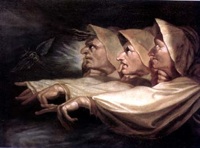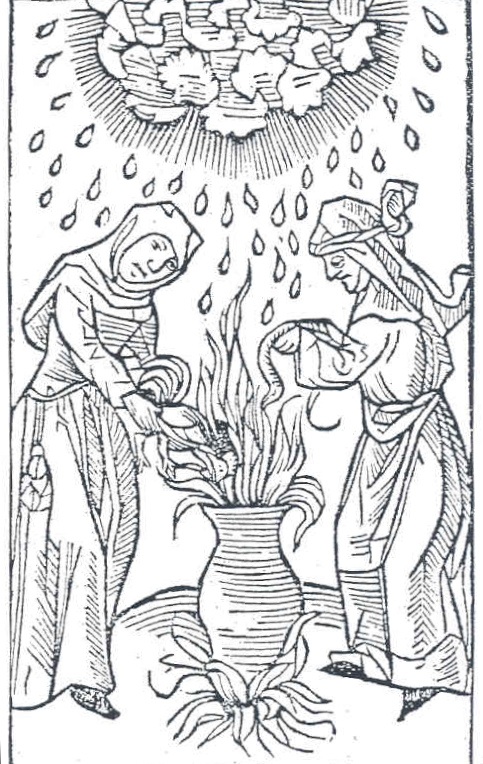

One of the "living environments" we want to create for this production (see the Production Design page for more details) will be the witches' grove.
While the witches are one of the most striking and memorable aspects of Macbeth, many of the witch scenes in the play were not written by Shakespeare at all. They were taken from another play, by Thomas Middleton, and added to Macbeth by Shakespeare's acting company after he had died. They draw heavily on the conventional theatrical stereotypes of Shakespeare's time, giving us witches that are sometimes scary, sometimes silly.
We want to delve a little deeper with our witches. Shakespeare's historical source for the events of the play, Holinshed's Chronicles, says that the witches who appeared to Macbeth and Banquo looked like "creatures of elder world," and that many people thought they were "the goddesses of destiny." This is in keeping with the way the witches refer to themselves in their dialogue: they call themselves "the weïrd sisters," where "weïrd" comes from the Old English term wyrd, meaning "fate" or "destiny." And the primary power that the witches have in the play is indeed the ability to prophesy about what will happen in the future.
This set of ideas links the witches of the play back to the older, pre-Christian mythological traditions of early Europe. They stand in a line of "goddesses of destiny" such as the Norns of Norse mythology and the Greek Fates. These figures have had a powerful attraction for many artists; we've been drawn, for example, to a number of images of the Norns by Arthur Rackham, including this one:

We want to create a whole community of witches, and restore to them some of the power implicit in the traditions on which they draw. Our witches form a separate community that exists on the outskirts of society in 11th-century Scotland, the time when the historical Macbeth lived. This "weïrd sisterhood" stands in opposition to the male-dominated, Christian world of the kings and thanes and soldiers of Scotland. It is a community of women, one that holds to older, pre-Christian beliefs and practices. Might the men who held power in the mainstream of Scottish society not think of such women as witches?
This set of ideas was the starting point for our approach to these witch characters. Each actor created a distinct individual identity for her witch, and the witch ensemble played a major role in creating the environment where the witches live and the interactions within the witch community that you see in the performances.
Shakespeare's Macbeth was written not long after King James VI of Scotland became James I of England in 1603, and James' interest in the subject of witchcraft undoubtedly influenced the play.
James had become convinced of the danger of witchcraft when he sailed to Copenhagen in 1590 to marry Princess Anne, sister of the King of Denmark. During their return to Scotland, they experienced terrible storms and had to shelter in Norway for several weeks before continuing. The admiral of the escorting Danish fleet blamed the storm on witches. Several nobles of the Scottish court were implicated, and soon more than a hundred suspected witches in North Berwick in Scotland were arrested.

James examined one of the accused, Agnes Sampson, himself. She refused to confess, so she was stripped, shaved, and examined until the devil's mark was found on her, then she was tortured anyway, attached to the wall of her cell by a "witch's bridle" (a metal torture device with sharp prongs which are forced into the mouth), and deprived of sleep. Finally she confessed, saying that a group of witches had come together on Halloween and plotted to work magic against the king. The confession led to many of the accused being burned, and to King James' great fear of witches. He wrote a book on the subject, Daemonologie, in 1597. (Dramaturgical notes by Karen Gellman.)

Our awareness of the long history of witchcraft persecutions in Europe has been an important factor in shaping our approach to the witches in this production. We hope to look behind the hysteria and the theatrical stereotypes and find something more complex, human, and perhaps even sympathetic in our witches...
